| کد مقاله | کد نشریه | سال انتشار | مقاله انگلیسی | نسخه تمام متن |
|---|---|---|---|---|
| 8886760 | 1627899 | 2017 | 9 صفحه PDF | دانلود رایگان |
عنوان انگلیسی مقاله ISI
Temperature and food-mediated variability of European Atlantic sardine recruitment
ترجمه فارسی عنوان
تنوع متغیرهای درجه حرارت و مواد غذایی در استخدام اروپایی ساردین آتلانتیک
دانلود مقاله + سفارش ترجمه
دانلود مقاله ISI انگلیسی
رایگان برای ایرانیان
موضوعات مرتبط
مهندسی و علوم پایه
علوم زمین و سیارات
زمین شناسی
چکیده انگلیسی
The influence of the environmental conditions during larval development on the resulting recruitment strength was investigated for European sardine (Sardina pilchardus) at Atlanto-Iberian waters. Satellite-derived Sea Surface Temperature (SST) and Chlorophyll-a concentration (Chla) data from the previous spawning seasons (January to March/April and October to December of the previous year) were related to recruitment success data in the main recruitment hotspots. Recruitment data was taken from yearly acoustic scientific cruises and from the ICES recruitment index estimated by an age-structured model for the entire stock. A linear discriminant analysis model using SST, Chla, and the abundance of spawners during the spawning season identified years of high and low recruitment for all the recruitment hotspots with an accuracy of â¥79%. In general, high recruitment years were associated with high Chla and low SST, although the most important variables to discriminate between the groups were area-specific. High recruitment years were mostly related to high food availability (Chla), particularly during the last quarter of the previous year. In Western Iberia and in the Gulf of Cadiz, high recruitment years were also associated to lower SST, whereas in the Bay of Biscay, where SST during the winter was generally below the optimal range â11-12â¯Â°C for sardine larval development, higher recruitment was associated with high SST. For ICES data of the southern European sardine stock, lower SST and higher Chla during the last quarter of the previous year were associated with high recruitment years and SST alone was able to discriminate between the two recruitment groups with 73% accuracy. Although the time-series of available data are still small, these significant relationships are consistent with field and laboratory studies relating larval growth and mortality with main environmental drivers. These relationships should be further investigated in the following years to evaluate if they can be used to construct reliable indicators to predict the level of recruitment and abundance with sufficient advance to help in the management of this important fishing resource.
ناشر
Database: Elsevier - ScienceDirect (ساینس دایرکت)
Journal: Progress in Oceanography - Volume 159, December 2017, Pages 267-275
Journal: Progress in Oceanography - Volume 159, December 2017, Pages 267-275
نویسندگان
Susana Garrido, Alexandra Silva, Vitor Marques, Ivone Figueiredo, Philippe Bryère, Antoine Mangin, A. Miguel P. Santos,
